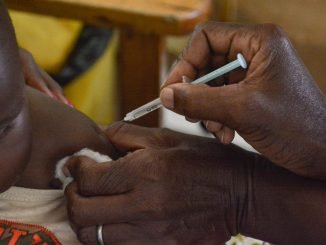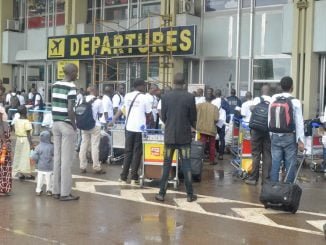
Kampala, Uganda | URN | A CT scan recommended by the Uganda Police has revealed that 25-year-old Muhammad Kabanda, who accused Old Kampala Hospital of harvesting his kidney was born without the second kidney.
According to an abdominal scan conducted by Associate Professor Kiguli Malwadde, a specialist radiologist at Kampala Imaging Centre, Kabanda was born with only the right Kidney, a condition medically known as renal agenesis. Medics say that children with one kidney are perfectly healthy and live normal lives. However, they require monitoring to keep their single kidney healthy.
Earlier this week, Kabanda opened a case with Old Kampala Police Station alleging that his left kidney was removed when he went for treatment of injuries he sustained during an accident. He says that he was asked to pay 3.35 million Shillings to cover the operation on his forehead which was severely injured during the accident.
He was taken for surgery on September 25, 2022, by a doctor he identified as Dr Alex Mugalu. To his dismay, Kabanda says that when he left the theater, he had two wounds, one on his forehead and another on his abdomen. However, the surgeon said that he had taken body tissue from the abdomen to cover the head injury.

But Kabanda suspected that his organs were harvested forcing him to conduct scans from Malcolm Health Care and Mengo Hospital which revealed that he had one kidney. He subsequently reported the matter to police.
As police launched investigations into the matter, Dr Richard Ambayo, a police surgeon recommended an abdominal pelvis CT scan and a brain CT scan to be conducted either at Mulago Hospital or Kampala Imaging Centre. In his referral notes, Dr Ambayo sought to understand whether Kabanda had one or two kidneys and if a medical procedure had been conducted to harvest any of them. Kabanda went for the scans on Friday.
On Saturday morning, Dr Moses Byaruhanga, the Director of Police Health Services presented the report of the abdominal pelvic CT scan from Kampala Imaging Centre to Kabanda and some of his family members which showed that Kabanda was born with one kidney which was bigger in size than the normal kidney and that he had multiple renal arteries yet usually, there is only one artery per kidney.
“A renal artery is supposed to be one but this one they are seeing multiple renal arteries in order to support this abnormal kidney on the right and to compensate for what is missing on the left. This is what the scan is reporting” explained Dr Byaruhanga.
He added that it was absurd that the surgeon picked a tissue from the very side where there is no kidney and that this is a coincidence. Dr Byaruhanga explains that when a surgeon needs a tissue to use during the operation, it is taken from the patient’s body because these are compatible and hard for the body to reject.
“When you need to make a repair on a patient under surgery, you have to get that tissue from the patient because the body may reject a foreign tissue from another person and you react,” Dr Byaruhanga said, adding that the tissue is taken from a section of the body which has some fat and that the cutting to get a tissue is made on the surface, not deep into the body.
Dr Byaruhanga further explained that the incision made on Kabanda’s abdomen is unlikely to be one for kidney harvesting because it was small, about 10 centimetres. He says that usually when taking out a big organ like a kidney, a surgeon would make a bigger cutting.
Kabanda however expressed further discontent and still doubts the results that indicated that he was born with one kidney.
Meanwhile, Dr Ssentongo Katumba, the registrar of the Uganda Medical Council says that they launched investigations into the matter and have since received a defence and the patient’s file from the hospital and the accused doctor. Dr Katumba says they have invited Kabanda for an examination to help them conduct an independent investigation.
“We need to know what really happened. We hope that he will come on Monday and we examine him. It is important that we get answers and also inform the public because the matter is in the public domain and people need to know what happened,” Dr Katumba said.
Read Also: Labour export firms reject Sudhir’s hospital for body organ testing
This publication sought an independent view from Dr Simon Peter Eyoku, a nephrologist from Mulago hospital who shared similar sentiments to Dr Byaruhanga. He said that in the past, the kidney would be accessed through the back side, and not the tummy and lately, surgeons use a keyhole surgery known as laparoscopy, a procedure which allows them to access the inside of the abdomen and pelvis without having to make large cuts in the skin. Usually, this procedure doesn’t even leave a scar on the skin.
He, however, acknowledged that the kidney can also be accessed from the front by cutting the stomach which creates a scar like the one seen on Kabanda’s body. Dr Eyoku however says that the technology needed to get a kidney and store it, is so advanced and not present in Uganda now. He says when an organ such as a kidney is harvested, it cannot last more than 24 hours outside.
“Usually in countries where such procedures are done, the patient is in one room and the organ donor in another both ready for the procedure. The organ is harvested from one person and implanted in the other,” he explained.
Dr Eyoku says that usually, the organ donor and the prospective recipient are investigated for close to two months before the procedure is conducted to ensure that the donor is in good health to donate the organ and that the organ has a high chance of compatibility with the recipient. In the event that there is no immediate recipient, Dr Eyoku says, advanced technology is required to store it.



